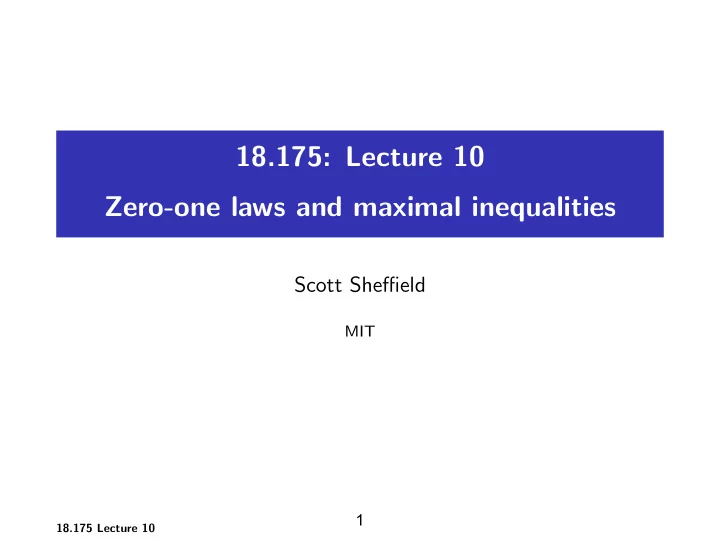

18.175: Lecture 10 Zero-one laws and maximal inequalities Scott Sheffield MIT 1 18.175 Lecture 10
Outline Recollections Kolmogorov zero-one law and three-series theorem 2 18.175 Lecture 10
Outline Recollections Kolmogorov zero-one law and three-series theorem 3 18.175 Lecture 10
Recall Borel-Cantelli lemmas S ∞ � First Borel-Cantelli lemma: If P ( A n ) < ∞ then n =1 P ( A n i.o. ) = 0. � Second Borel-Cantelli lemma: If A n are independent, then S ∞ P ( A n ) = ∞ implies P ( A n i.o. ) = 1. n =1 4 18.175 Lecture 10
Recall strong law of large numbers Theorem (strong law): If X 1 , X 2 , . . . are i.i.d. real-valued � � n − 1 random variables with expectation m and A n := n S i =1 X i are the empirical means then lim n →∞ A n = m almost surely. 5 18.175 Lecture 10
Outline Recollections Kolmogorov zero-one law and three-series theorem 6 18.175 Lecture 10
Outline Recollections Kolmogorov zero-one law and three-series theorem 7 18.175 Lecture 10
Kolmogorov zero-one law Consider sequence of random variables X n on some probability � � space. Write F � = σ ( X n , X n 1 , . . . ) and T = ∩ n F � . n n T is called the tail σ -algebra . It contains the information you � � can observe by looking only at stuff arbitrarily far into the future. Intuitively, membership in tail event doesn’t change when finitely many X n are changed. Event that X n converge to a limit is example of a tail event. � � Other examples? Theorem: If X 1 , X 2 , . . . are independent and A ∈ T then � � P ( A ) ∈ { 0 , 1 } . 8 18.175 Lecture 10
Kolmogorov zero-one law proof idea Theorem: If X 1 , X 2 , . . . are independent and A ∈ T then � � P ( A ) ∈ { 0 , 1 } . Main idea of proof: Statement is equivalent to saying that A � � is independent of itself, i.e., P ( A ) = P ( A ∩ A ) = P ( A ) 2 . How do we prove that? Recall theorem that if A i are independent π -systems, then � � σ A i are independent. Deduce that σ ( X 1 , X 2 , . . . , X n ) and σ ( X n +1 , X n +1 , . . . ) are � � independent. Then deduce that σ ( X 1 , X 2 , . . . ) and T are independent, using fact that ∪ k σ ( X 1 , . . . , X k ) and T are π -systems. 9 18.175 Lecture 10
MIT OpenCourseWare http://ocw.mit.edu 18.175 Theory of Probability Spring 2014 For information about citing these materials or our Terms of Use, visit: http://ocw.mit.edu/terms.
MIT OpenCourseWare http://ocw.mit.edu 18.175 Theory of Probability Spring 2014 For information about citing these materials or our Terms of Use, visit: http://ocw.mit.edu/terms.
Recommend
More recommend